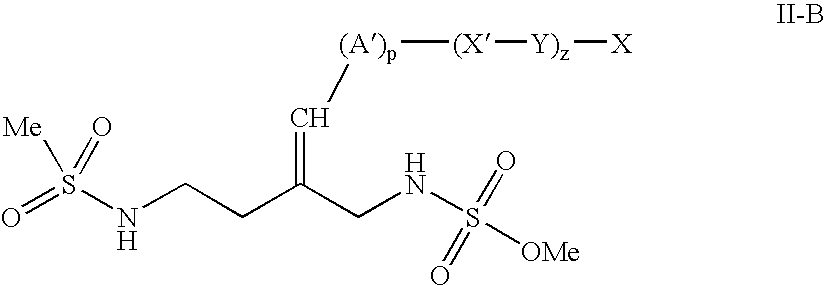Busulfan immunoassay
a technology of immunoassay and busulfan, which is applied in the field of immunoassay, can solve the problems of laborious gc/ms, debilitating side effects of compounds, and high cost of compounds
- Summary
- Abstract
- Description
- Claims
- Application Information
AI Technical Summary
Benefits of technology
Problems solved by technology
Method used
Image
Examples
example 1
Preparation of Busulfan Derivative [7] (Scheme 1)
[0115]To a suspension of 1,4-diamino-2-butanone dihydrochloride (0.193 g, 1.1 mmol) and TEA (0.76 mL, 5 eq) in 8 mL of chloroform was added dropwise di-tert-butyldicarbonate (0.48 g, 2 eq.) in 2 mL of chloroform. The resulting mixture was refluxed for 3 hours, cooled to room temperature, diluted with 50 mL of chloroform, and washed with 1 N HCl (2×15 mL), H2O (20 mL), Saturated NaHCO3 (25 mL), and brine (30 mL), then dried over sodium sulfate for ½ hour. Concentration of the organic layer gave the product [1] (yellow solid, 95% yield). The product's structure was confirmed by NMR.
[0116]To a solution of [1] (0.9 g, 3 mmol) and triethyl 4-phosphonocrotonate (1.6 mL, 2.2 eq) in 15 mL of dry THF was added sodium hydride (0.26 g, 2.2 eq.) by portions. The resulting mixture was stirred at room temperature for 2 hours. TLC showed that the reaction was not totally complete. Removal of the solvent yielded a residue, which was taken up with EtO...
example 2
Preparation of Busulfan Derivative [11] Scheme 2
[0122]To a suspension of compound [2] from example 1 (0.43 g, 1.08 mmol) in 1 mL of chloroform was added 4 mL of trifluoroacetic acid. The resulting mixture was stirred at room temperature for ½ hour. Removal of the solvent and extra TFA yielded compound [8] as a brown oil; structure was confirmed by NMR. This material was used in the next reaction without further purification (100% yield).
[0123]To a suspension of compound [8] (0.43 g, 1 mmol), with TEA (2.8 mL, 20 eq.) in 10 mL of chloroform in an ice-water bath was added drop wise methane sulfonyl chloride (0.8 mL, 10 eq) in 5 mL of chloroform. The resulting mixture was allowed to warm up to room temperature and stirred at room temperature overnight. Removal of the solvent yielded the crude product [9] (brown oil), which was purified by flash column chromatography with EtOAc / Hexane solvent system (30% yield). The structure was confirmed by NMR.
[0124]A mixture of the ethyl ester [9] (...
example 3
Preparation of Busulfan BTG Immunogen
[0126]To 17 mL of BTG (21.2 mg / mL) in 50 mM phosphate buffer (50 mM, pH 7.5) 0.625 mL of the activated N-Hydroxysuccinimide ester busulfan derivative [7] prepared in example 1 (40 mg / mL in DMSO) was added drop wise while stirring the solution in an ice bath. The resulting mixture was allowed to stir overnight at room temperature to conjugate the BTG to the busulfan derivative [7]. This immunogenic conjugate was then purified by dialysis and characterized according to procedures described previously (Wu et. al., Bioconj. Chem., 8: pp 385–390, 1997, Li et.al., Bioconj. Chem., 8: pp 896–905, 1997, Salamone et.al., J. Forensic Sci. pp 821–826, 1998).
PUM
| Property | Measurement | Unit |
|---|---|---|
| diameter | aaaaa | aaaaa |
| diameter | aaaaa | aaaaa |
| diameter | aaaaa | aaaaa |
Abstract
Description
Claims
Application Information
 Login to View More
Login to View More - R&D
- Intellectual Property
- Life Sciences
- Materials
- Tech Scout
- Unparalleled Data Quality
- Higher Quality Content
- 60% Fewer Hallucinations
Browse by: Latest US Patents, China's latest patents, Technical Efficacy Thesaurus, Application Domain, Technology Topic, Popular Technical Reports.
© 2025 PatSnap. All rights reserved.Legal|Privacy policy|Modern Slavery Act Transparency Statement|Sitemap|About US| Contact US: help@patsnap.com



